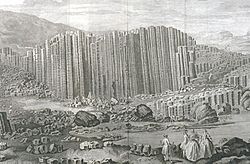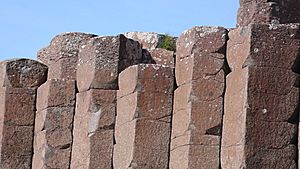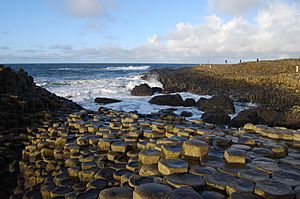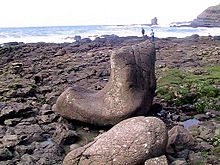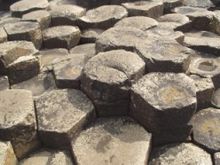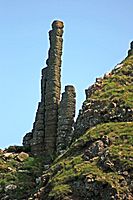Giant's Causeway facts for kids
Quick facts for kids Giant's Causeway and Causeway Coast |
|
|---|---|
| Native names Irish: Clochán an Aifir/Clochán na bhFomhórach English: Tha Giant's Causey |
|
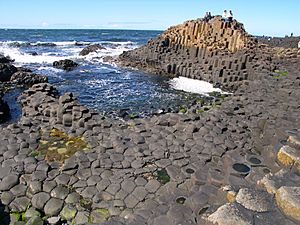
The Giant's Causeway
|
|
| Location | County Antrim, Northern Ireland |
| Official name: The Giant's Causeway and Causeway Coast | |
| Type | Natural |
| Criteria | (vii), (viii) |
| Designated | 1986 (10th session) |
| Reference no. | 369 |
| Region | Europe |
| Lua error in Module:Location_map at line 420: attempt to index field 'wikibase' (a nil value). | |
The Giant's Causeway (called Clochán an Aifir in Irish) is a truly amazing place in Northern Ireland. Imagine about 40,000 stone columns, all fitting together like a giant puzzle! These columns were formed a very long time ago by a volcano that erupted. It's located on the north coast of County Antrim, near the town of Bushmills.
In 1986, UNESCO recognized the Giant's Causeway as a World Heritage Site. This means it's a special place that is important to the whole world. The UK also named it a national nature reserve in 1987. Many people think it's one of the greatest natural wonders in the United Kingdom.
The tops of these columns look like stepping stones that go from the cliffs right into the sea. Most of them have six sides, like a hexagon, but you can find some with four, five, seven, or even eight sides! The tallest columns are about 12 meters (40 feet) high. The ancient lava that formed them is up to 28 meters (92 feet) thick in some places along the cliffs.
The National Trust takes care of most of the Giant's Causeway. It's a very popular spot for visitors in Northern Ireland, with almost a million people visiting in 2019. You can visit the Giant's Causeway for free. You don't have to pay to walk on the columns. Other parts of the area are owned by the Crown Estate and private landowners.
Contents
How the Giant's Causeway Was Formed
About 50 to 60 million years ago, a long, long time before humans, the area of Antrim was very active with volcanoes. Hot, melted rock called basalt flowed out of the Earth. This lava spread over the land, forming a huge flat area called a volcanic plateau.
As this hot lava slowly cooled down, it began to shrink. This shrinking caused the rock to crack, much like mud cracks when it dries. These cracks went deep into the lava, creating tall, pillar-like shapes. These pillars also cracked horizontally, making them look like stacks of biscuits. Often, one side of a horizontal crack is rounded (convex), and the other side is curved inwards (concave). This creates what looks like "ball and socket" joints, allowing the columns to fit together. The speed at which the lava cooled determined how big these columns became. This amazing network of cracks created the unique columns we see today. These basalts were once part of an even bigger volcanic area called the Thulean Plateau.
A Special Geological Site
The Giant's Causeway is very important for understanding how volcanoes work and how basalt rock forms. Because of its significance, the International Union of Geological Sciences (IUGS) included it in a list of 100 "geological heritage sites" around the world in October 2022. This shows how special the rocks of the Giant's Causeway and Causeway Coast are to scientists.
The Legend of Finn MacCool
There's a famous old story, a geomyth, about how the Giant's Causeway was built. It says that the columns are the remains of a path made by a giant! The legend tells of an Irish giant named Fionn mac Cumhaill (pronounced Finn MacCool). He was challenged to a fight by a Scottish giant named Benandonner.
Finn MacCool decided to build a causeway (a raised road) across the sea to Scotland so they could meet and fight. In one version of the story, Finn bravely defeats Benandonner. But in another popular version, Finn realizes that Benandonner is much, much bigger than him! So, Finn's clever wife, Sadhbh, disguises Finn as a baby and puts him in a cradle.
When Benandonner arrives and sees the enormous "baby," he gets scared. He thinks, "If the baby is this huge, imagine how enormous its father, Finn, must be!" Terrified, Benandonner runs back to Scotland. As he flees, he destroys the causeway behind him so Finn can't follow. Interestingly, there are similar basalt columns in Fingal's Cave on the Scottish island of Staffa. This might have inspired parts of the legend!
It's good to know that in most Irish mythology, Finn MacCool is usually seen as a hero with special powers, not always a giant. Over time, many old Irish heroes and gods in stories became known as giants or fairies. The Irish name for the Causeway, Clochán na bhFomhóraigh, means "stepping stones of the Fomhóraigh." The Fomhóraigh were mythical beings in Irish stories, sometimes described as giants.
Visiting the Giant's Causeway
People have been fascinated by the Giant's Causeway for a long time. In 1692, William King, a bishop, visited the site. The wider world learned about it in 1693. Later, in 1739, a Dublin artist named Susanna Drury created beautiful watercolor paintings of the Causeway. These paintings helped the site become famous internationally. In 1765, the Causeway was even featured in a French encyclopedia! A French geologist, Nicolas Desmarest, was the first to suggest in print that these amazing structures were formed by volcanoes.
The Giant's Causeway became a popular place for tourists in the 1800s. The National Trust took over its care in the 1960s. They worked to protect its natural beauty. Even Emperor Pedro II of Brazil visited the site in 1877!
Today, visitors can walk right onto the basalt columns at the edge of the sea. It's about a half-mile walk from the entrance.
The Visitor Centre
For a while, between 2000 and 2012, the Causeway didn't have a permanent visitor centre because the old one burned down. A new visitor centre officially opened in 2012. Its construction was supported by the National Trust and other groups.
The new visitor centre has received different opinions from visitors about its design and cost. Inside, there was some discussion about how the age of the Earth was explained. The National Trust made sure that the main focus of the exhibition is the scientific explanation for how the stones were created 60 million years ago. Other ideas, like those from some religious communities about the Earth's age, are also mentioned. However, they are presented as traditional beliefs, not as scientific explanations for the Causeway's origin.
Amazing Rock Shapes
Over millions of years, the wind and sea have shaped some of the columns into interesting forms. People have given them fun names! You can see structures that look like an Organ or a Giant's Boot. There are also reddish, lower columns called Giant's Eyes. Other cool features include the Shepherd's Steps, the Honeycomb, the Giant's Harp, the Chimney Stacks, the Giant's Gate, and the Camel's Hump.
Plants and Animals at the Causeway
The Giant's Causeway is a wonderful home for many seabirds. You might spot fulmars, petrels, cormorants, shags, redshanks, guillemots, and razorbills flying around.
The unique rock formations also support many types of plants. Look for sea spleenwort, hare's-foot trefoil, vernal squill, sea fescue, and frog orchid. In 2011, a rare colony of stromatolites was found here. These are usually found in warmer, saltier waters, making their presence at the Causeway very special!
Other Similar Places
Basalt columns like those at the Giant's Causeway are a type of volcanic feature found in many places around the world. They can look a bit different depending on how they formed, but they all come from cooling lava.
How to Get There
You can reach the Giant's Causeway by train. The Belfast-Derry railway line connects to Coleraine. From there, you can take a branch line to Portrush. Local buses also connect to the railway stations. There's also a beautiful 7-mile walk from Portrush that passes by Dunluce Castle before reaching the Giant's Causeway and Bushmills Railway.
Related pages
See also
 In Spanish: Calzada del Gigante para niños
In Spanish: Calzada del Gigante para niños
- List of individual rocks
- List of tourist attractions in Ireland


